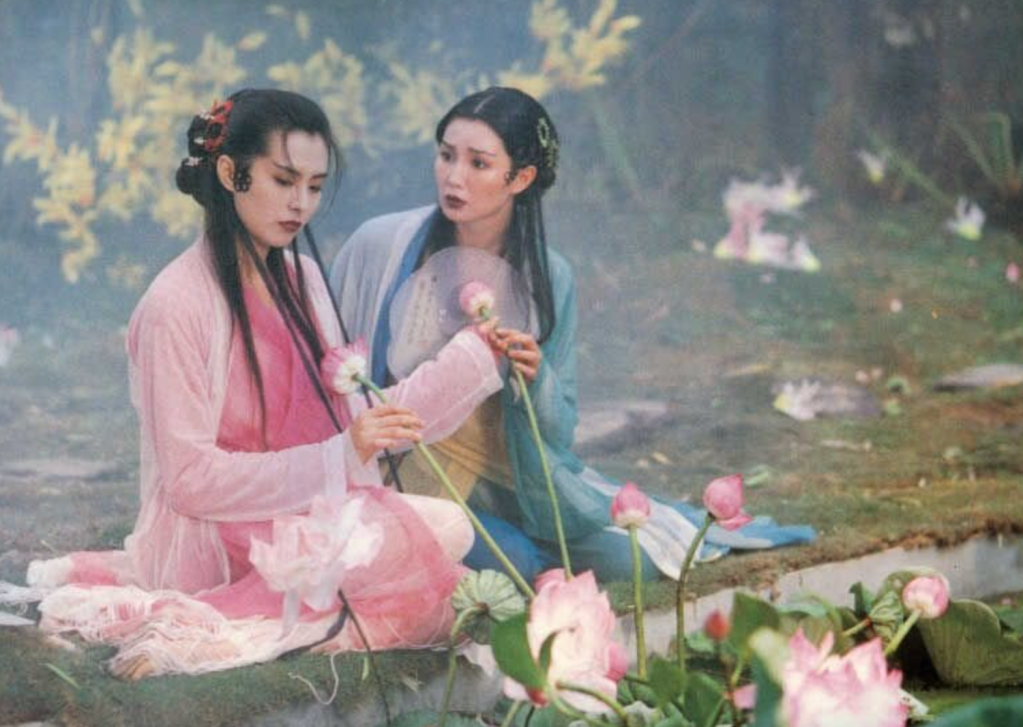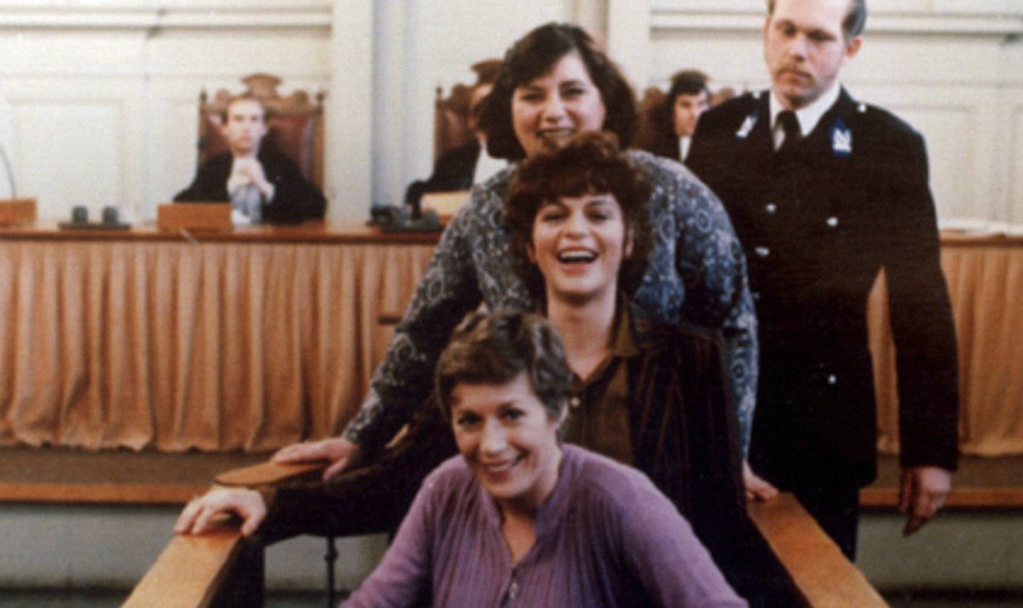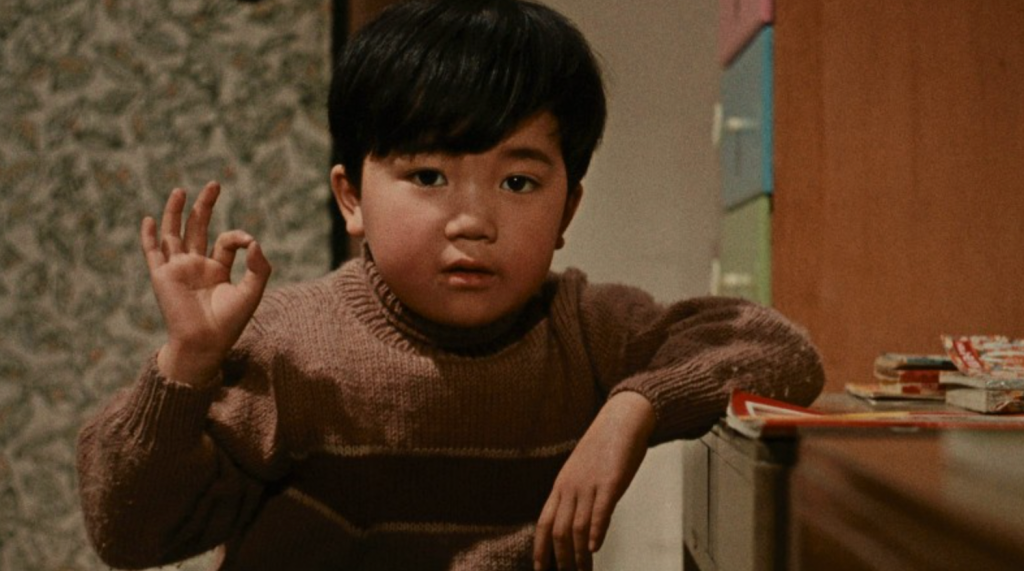This is the sixth edition of Odds & Ends, a capsule-review column collecting brief notes on movies taken throughout the month.
Dark Angel: The Ascent (1994), dir. Linda Hassani
An often expressionless redhead mills around town calmly killing people one could say deserve it: a man attempting to rape a woman on the street; a pair of white policemen needlessly harassing a Black man in the dead of night. That’s basically the gist of Dark Angel: The Ascent, a surprisingly stylish and intoxicatingly moody direct-to-video horror romance about a demoness from Hell (no other way to put it) who one day decides to abscond to Earth, so tired of the monotony of torturing people in the afterlife that she craves the change of pace humanly pleasures could provide. (Once among mortals, she bides her time by doing the above-mentioned dirty work: getting those she knows will go to Hell there faster.) As the main character, Angela Featherstone decently handles the often risible dialogue mining the occasional comedy coming from her character’s earthly naïveté. I like her character best when she’s mellowly approaching bloody justice more than I do when she’s romancing a doctor (Daniel Markel) she says has the gentlest soul she’s ever encountered. It’s always a drag when a chaotic character in a movie’s disruptions are doomed for some straightening out.
Late Night with the Devil (2024), dir. Colin Cairnes and Cameron Cairnes
This low-budget horror movie has gotten a lot of (rightful) flack for using AI to make some of its intertitle art; that creative unimaginativeness isn’t only confined to that instance of unpardonable corner-cutting. Late Night with the Devil is presented like the hard-to-find last episode of a 1970s talk show that had infamously descended into bedlam when its gimmick-desperate host (David Dastmalchian) invited on a young girl who had apparently been possessed by a demonic entity not long ago. The movie continuously undermines its own aesthetic novelty by showing crystal-clear, black-and-white “never-before-seen” footage of what was happening backstage during the broadcast — as if the people wielding the studio cameras suddenly became proficient, omniscient documentarians — and also, in general, cultivates nearly no suspense after decently setting up its intriguing premise. The similarly conceived Ghostwatch (1992) and WNUF Halloween Special (2013) do what Late Night with the Devil wishes it did and manage not to compromise themselves along the way. They’re essential; Late Night with the Devil’s AI controversy will be the only thing it’s remembered for.
Salt (2010), dir. Philip Noyce
Shortly after Salt opens, the titular CIA agent (Angelina Jolie) is accused of being a Russian sleeper agent just hours before the anniversary dinner she had planned with her husband. Her co-workers take the accuser’s insinuations at face value; knowing what could come next, she tears out of the office and spends nearly all the rest of this flinty and unrelenting thriller on the run, proverbially flipping the bird to physics in the process. (She will, during one sequence, dart from the top of one loading truck to another on different sections of the freeway; she will, in another, dive out from a helicopter into the cold sea when out of options for an easy escape.) Much was made around the time of the film’s release that Tom Cruise was supposed to star as this protagonist with chronically fogged loyalties. Karina Longworth, writing for The Village Voice, aptly points out that the pointed murkiness “gives us an action-hero prototype that Cruise couldn’t play but Jolie was born to … Jolie is all about ambiguity and always has been.” You couldn’t imagine anybody else in the role. As she is in all her action movies, Jolie is lithe and electric in the kind of way that might make you think no one has looked cooler in a movie shooting a gun or incapacitating a man inferior in combat. One could call the movie convoluted and mean it pejoratively. If I call it that, I mean it complimentarily. No good action movie isn’t at least a little ridiculous; Salt unapologetically goes all in, explaining itself only as much as it needs to before moving on.

Joey Wong and Maggie Cheung in Green Snake.
Green Snake (1993), dir. Tsui Hark
In Green Snake, a fantasy that has the distinction of being one of the most gorgeously shot movies I’ve ever seen, the camera is like a restless bird, soaring and careening around an otherworld where color only ever pops and the air always seems wet with mist or fog. The movie, set in unspecified ancient times, follows two sisters who were born snakes but have been practicing, for decades, to live comfortably in human form. One of them (Joey Wong) longs to assimilate among humans and eventually falls in love with a local scholar (Wu Hsing-Kuo); the other sees humanity as not much more than a game, eager to transform back into her long-tailed self after a long and tiring day walking around on two feet (Maggie Cheung). I’ll admit that I only half-cared about the story; my eyes were too busy feasting to concentrate very hard on much else.
Cherry 2000 (1988), dir. Steve De Jarnatt
Melanie Griffith’s performance in Cherry 2000 suggests a person who would rather not be here. Once I got past the half-hour mark of the movie and unwisely decided to stick around, I could relate. I didn’t, couldn’t, give a fuck about its bland protagonist desperately seeking a replacement for his robot girlfriend. (He stupidly, and lethally, had spur-of-the-moment sex with her on the kitchen floor, soaked with water and suds after the dishwasher malfunctions.) The movie is set in a post-apocalyptic future — 2017, to be exact — and he has to hire Edith, a red-haired bounty hunter played by Griffith, to protect him while he roams dangerous grounds looking for an exact replica of the “woman” he once loved. This will, of course, only lead to a romance between this chemistry-parched pair. I would have preferred it if Edith just kicked his ass and robbed him.
Beverly Hills Madam (1986), dir. Harvey Hart
In Beverly Hills Madam, Faye Dunaway plays the steely, blonde, and immaculately dressed title character, presiding coolly over a small stable of young and beautiful sex workers to whom screenwriter Nancy Sackett gives rote-but-sympathetic individual storylines that bespeak just how hostility-prone society is to those who go the professional route they do. The movie, which was made for TV, feels like it’s going through the motions while traversing its subplots; it’s no surprise that when a scene centers on Dunaway — dependably a force when tasked with playing someone hardened and hard to fuck with — it hums with sudden vitality whose pulse weakens the more the movie moves into inexorable melodramatic moralization.

From A Question of Silence.
A Question of Silence (1982), dir. Marleen Gorris
An essential work of feminist filmmaking, Gorris’ feature-length debut follows a psychiatrist, Janine (Cox Habbema), as she probes the psyches of three women (Edda Barends, Nelly Frijda, and Henriëtte Tol) who, despite being complete strangers to each other, one day murdered and then castrated the male owner of a dress shop they were perusing ostensibly for no other reason besides his gender. The more Janine talks to the women — all personally and professionally beaten down in some way or another by the constant weight of patriarchy — the more she sympathizes with a last straw-style act of violence more symbolic than personal to the victim. Gorris doesn’t so much condone the murder as compassionately make evocative an all-too-common strain of frustration whose endpoint does not typically end up the way it does here. At the film’s climax, the prosecuting attorney suggests that these women would have committed the same act regardless of gender. What seems to be all the women in the courtroom erupt in a shared fit of bemused laughter — a powerful sound.
The Captive (2000), dir. Chantal Akerman
Akerman’s loose adaptation of the Marcel Proust novel La Prisonnière is an eerie, often inscrutable story of obsession. Simon (Stanislas Merhar) is the man consumed; he lives with his grandmother (Françoise Bertin) and his girlfriend, Ariane (Sylvie Testud), and subjects the latter specifically to a progressively frightening level of control and scrutiny. She cannot go anywhere without the chance of him trailing her by car; she cannot go to a function with friends without him potentially barging into the room to drag her out. Much of this behavior is rooted in the knowledge of Ariane living mostly as a lesbian before getting together with Simon. He cannot stop thinking about how he stacks up to her previous female companions — he worries they had special bonds he’ll never achieve as a man — and his all-consuming suspiciousness is not helped by Ariane’s chronic pleasantness around him, even when he’s on his worst behavior. (She doesn’t seem to mind how their sex life depends on her pretending to be asleep so that he can get aroused, for instance.) He can’t stand the idea of being kept in the dark about some aspects of Ariane’s inner life; she, in contrast, appreciates that there are always mysteries about a significant other, some able to be uncovered and some not. Akerman writes and directs from what can feel like a clinical distance, with a certain archness (particularly in the set design) underscoring the movie’s ruminative, rather than character-study-oriented, aims. It’s as compellingly elusive as the woman about whom Simon can’t stop thinking.
Sibyl (2019), dir. Justine Triet
The therapist lead (Virginie Efira) of Triet’s dark comedy just wants to step back and focus on what she’s always wanted to pursue but never really had time to: write. Then she gives into the lure of what she told herself she would not do — take on a new patient while she attempts to create — partially because the client, an actress named Margot (Adèle Exarchopoulos), poses what could be a good narrative for the book that’s not pouring out of her as quickly as she’d like. Margot is having an affair with, and has recently been impregnated by, her co-star (the late Gaspard Ulliel). The co-star’s girlfriend (Sandra Hüller) is also directing the movie for which the actors are currently in production. This all sounds like fodder for a farce. But though the movie can be funny, Triet has made a sharper, more emotionally complex movie about how the exhaustion of performing the different roles for the various people in our lives can mar one’s relationship with what they would like to be their genuine self.

Masahiko Shimazu in Good Morning.
Good Morning (1959), dir. Yasujirō Ozu
Set in a Tokyo suburb, Ozu’s lovable slice of life tracks the comically petty dramas of several of its neighborhood’s denizens. Most fixated on is the silent strike a couple of little boys (Shitara Koji and Masahiko Shimazu) go on in protest of their old-fashioned parents refusing to even indulge the idea of buying a TV so that they can watch baseball and wrestling. Good Morning is charming for its various sitcommy squabbles and often beautiful because of Yūharu Atsuta’s cinematography and Tatsuo Hamada’s lived-in production design. But there’s something more profound at work about how little misunderstandings and failures of communication can accrue into something ugly if not nipped in the bud early on.
Drowning Mona (2000), dir. Nick Gomez
This quirky whodunit comedy, set in a tiny New York town where everybody knows everybody, moves along pleasantly and is, for the most part, entertaining. But it’s never that funny or that clever in the construction of its guiding mystery; it can feel like the pilot for a primetime, hour-long dramedy series that never managed to get off the ground. The over-the-top wigs worn by the expensive cast — Casey Affleck has a blonde-butterball bob, Jamie Lee Curtis a mullet, Neve Campbell gargantuan, light brown-highlighted waves — suggest fretful compensation for something.
Sexy Beast (2000), dir. Jonathan Glazer
Though it’s formally daring, zigging and zagging between the past and the present to make sure we never quite have our bearings, I would not have guessed, if I were to watch then-music video director Glazer’s 2000 feature-length debut when it came out, that he would have gone on to make some of the most conceptually and visually bold films of his generation. It’s simply a sterling, stylish gangster movie featuring a pitch-perfectly over-the-top performance from Ben Kingsley as an antagonist that puts you in mind of Dennis Hopper in Blue Velvet (1986). It’s such a big, ravenous performance that it might consume everything else were Glazer’s touch not so confident. Glazer wouldn’t remain in this Guy Ritchie-adjacent mode for very long. His 2004 follow-up, Birth, would introduce the trademark chilliness he’d gradually expand on over the next couple decades.
